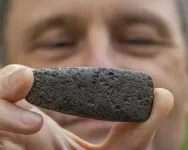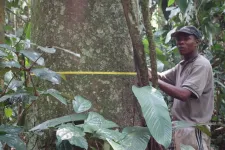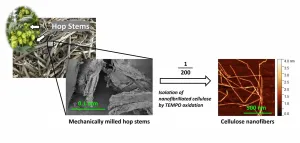American Journal of Medical Quality supplement explores innovative solutions to health care quality and performance improvement
2021-07-02
(Press-News.org) July 2, 2021 - For health care organizations looking to improve performance and patient experiences, implementing data-driven solutions can be effective when focusing on addressing health equity and reducing patient length of stay. These topics are explored in selected member-submitted abstracts from the 2020 Vizient® Connections Education Summit that appear in a special supplement to the July/August 2021 issue of the American Journal of Medical Quality, the official journal of the American College of Medical Quality (ACMQ).
Interventions for addressing health equity
To help health care organizations address health equity, Andrew S. Resnick, MD, MBA, Brigham and Women's Hospital, Karthik Sivashanker, MD, MPH, CPPS, Brigham and Women's Hospital, and Tam Duong, MS, Institute for Healthcare Improvement, developed an intervention framework that "provides a road map for organizations to advance equitable and safe care to all patients by using current patient safety reporting mechanisms to identify events pertaining to explicit, implicit, individual, group, and structural biases." The events identified are then analyzed to identify effective solutions and track their implementation. The authors tested the framework at Brigham and Women's Hospital and saw an "80-fold increase in actions taken from root cause analysis to addressing inequities." Learn more in the abstract "Equity Is a Patient Safety Emergency."
Using data to reduce length of stay
Over the last four years, the Vizient length of stay (LOS) index at Memorial Hermann Texas Medical Center has had a downward trend that plateaued in the past year. The stall in the LOS index has led to nursing units reaching capacity and to an increase in patient wait times for beds. To ensure that resources are allocated appropriately, Stephen W. Simington, MS, MPH, Memorial Hermann Texas Medical Center, and Bela Patel, MD, Memorial Hermann Texas Medical Center/UT Health, developed a statistical dashboard using the Vizient Clinical Data Base to help the health system "identify data-driven opportunities that focus on maximizing resources in the greatest areas of opportunity." The authors expect that the use of the tool and subsequent interventions will show a reduction in the LOS index over time. Learn more in the abstract "Four Clicks from Vizient Data to Actional Information."
INFORMATION:
Click here to read the supplement "Future in Focus: One Clear Vision," the 2020 Vizient Connections Education Summit Report.
DOI: 10.1097/01.JMQ.0000755648.57078.39
Background: Published bimonthly, the American Journal of Medical Quality (AJMQ) (http://www.ajmqonline.com) features original, peer-reviewed articles by noted experts in the field and is frequently cited as a literature source in medicine. AJMQ is focused on keeping readers informed of the resources, processes, and perspectives contributing to quality health care services. This peer-reviewed journal presents a forum for the exchange of ideas, strategies, and methods in improving the delivery and management of health care. Follow AJMQ on Twitter: @AjmQonline.
ELSE PRESS RELEASES FROM THIS DATE:
2021-07-02
GAINESVILLE, Fla. --- Archaeologists have unearthed a END ...
2021-07-02
MANHATTAN, KANSAS -- Research led by Kansas State University's Suprem Das, assistant professor of industrial and manufacturing systems engineering, in collaboration with Christopher Sorensen, university distinguished professor of physics, shows potential ways to manufacture graphene-based nano-inks for additive manufacturing of supercapacitors in the form of flexible and printable electronics.
As researchers around the world study the potential replacement of batteries by supercapacitors, an energy device that can charge and discharge very fast -- within few tens of seconds -- the team led by Das has an alternate prediction. The team's work could be adapted to integrate them to overcome ...
2021-07-02
A huge global network of researchers is working together to take the pulse of our global tropical forests.
ForestPlots.net, which is co-ordinated from the University of Leeds, brings together more than 2,500 scientists who have examined millions of trees to explore the effect of climate change on forests and biodiversity.
A new research paper published in Biological Conservation explains the origins of the network, and how the power of collaboration is transforming forest research in Africa, South America and Asia.
The paper includes 551 researchers and outlines 25 years of discovery in the carbon, biodiversity and dynamics of tropical forests.
Professor Oliver Phillips, of Leeds' School of Geography, said "Our new paper shows how we are linking students, botanists, ...
2021-07-02
MANHATTAN, KANSAS -- A recent study by Kansas State University virologists demonstrates successful postinfection treatment for SARS-CoV-2, the virus that causes COVID-19.
College of Veterinary Medicine researchers Yunjeong Kim and Kyeong-Ok "KC" Chang published the study in the prestigious journal Proceedings of the National Academy of Sciences of the United States of America, or PNAS. They found that animal models infected with SARS-CoV-2 and treated with a deuterated protease inhibitor had significantly increased survival and decreased lung viral load.
The results suggest that postinfection treatment with inhibitors of proteases that are essential for viral replication may be an effective treatment against SARS-CoV-2. ...
2021-07-02
How on Earth?
It has puzzled scientists for years whether and how bacteria, that live from dissolved organic matter in marine waters, can carry out N2 fixation. It was assumed that the high levels of oxygen combined with the low amount of dissolved organic matter in the marine water column would prevent the anaerobic and energy consuming N2 fixation.
Already in the 1980s it was suggested that aggregates, so-called "marine snow particles", could possibly be suitable sites for N2 fixation, but this was never proven.
Until now..
In a new study, researchers from the University of Copenhagen demonstrate, by use of mathematical models, ...
2021-07-02
During the large second wave of the COVID-19 pandemic in fall 2020, pulmonologist and critical care provider Juan C. Rojas, MD, reflected on how disproportionately members of minority populations were being affected by the disease. After hearing similar thoughts from colleagues in New Orleans and New York City, Rojas began to wonder how, if at all, state governments planned to ensure these disparities would be addressed when COVID-19 vaccines were rolled out to the public.
In a new study published July 2 in JAMA Network Open, Rojas and his team were surprised ...
2021-07-02
(Boston)--Would you be more willing to get vaccinated against the COVID-19 virus if you could participate in a lottery for cash and prizes? The answer was surprisingly no, according to Boston University School of Medicine (BUSM) researchers who found that Ohio's "Vax-a-Million" lottery-based incentive system, intended to increase COVID-19 vaccination rates, was not associated with an increase in COVD-19 vaccinations.
Prior reports in the media had suggested that the Ohio lottery increased COVID-19 vaccinations, leading other states to use COVID-19 vaccine incentive lotteries in an attempt to increase slowing vaccination rates. "However, prior evaluations of ...
2021-07-02
Some three quarters of the biomass in hop plants used in beer-making ends up in landfills. But a group of Japanese researchers has developed a technique that 'upcycles' that waste hop into cellulose nanofibers (CNFs). A paper describing the technique was published in the journal ACS Agricultural Science & Technology on June 11.
In the past few years, craft beer-making has exploded in popularity around the world, including many beer styles that make use of many more and different types of hops than conventional commercial beers. A traditional preservative in beer, hops also add ...
2021-07-02
Berkeley -- Many insects and spiders get their uncanny ability to scurry up walls and walk upside down on ceilings with the help of specialized sticky footpads that allow them to adhere to surfaces in places where no human would dare to go.
Engineers at the University of California, Berkeley, have used the principle behind some of these footpads, called electrostatic adhesion, to create an insect-scale robot that can swerve and pivot with the agility of a cheetah, giving it the ability to traverse complex terrain and quickly avoid unexpected obstacles.
The robot is constructed from a thin, layered material that bends and contracts when an electric voltage is applied. In a 2019 paper, the research team demonstrated that this simple ...
2021-07-02
Wander around a desert most anywhere in the world, and eventually you'll notice dark-stained rocks, especially where the sun shines most brightly and water trickles down or dew gathers. In some spots, if you're lucky, you might stumble upon ancient art - petroglyphs - carved into the stain. For years, however, researchers have understood more about the petroglyphs than the mysterious dark stain, called rock varnish, in which they were drawn.
In particular, science has yet to come to a conclusion about where rock varnish, which is unusually rich in manganese, comes from.
Now, scientists at the California Institute of Technology, the Department of Energy's SLAC National Accelerator ...
LAST 30 PRESS RELEASES:
[Press-News.org] American Journal of Medical Quality supplement explores innovative solutions to health care quality and performance improvement




